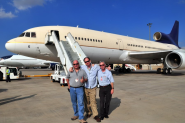
TriStar and Me
By Mark Barnard
December 15, 2009 was the last flight of the last TriStar off the production line. Number 250 of 250. It was to be an unceremonious and woefully ungracious end to the life of this significant airplane. A ferry from Riyadh, Saudi Arabia to what would ultimately prove to be its final resting place in Ras al Khaimah, UAE. Un-pressurized. Landing gear mechanically pinned in the down position. We were directed to take the airplane there ostensibly for storage until its D check could be accomplished, at the completion of which it would be returned to service. But those of us on the crew . . . well, we had all seen Big Guy’s lips move before. We knew the truth.
It began life as manufacturer’s serial number 193G-1250. Originally bound for the Royal Flight division of the government of Algeria, it was instead bought by Saudi Royal Flight. It was registered as HZ-HM5 during its years of service flying the Saudi Royal family, but with the purchase by my company, it was re-registered as N389LS. One of only two TriStars to come out of the factory in VIP configuration, its place in the production line was not the only thing that made the airplane unique.
My lifelong affair with the TriStar began the summer that I was 14 on a family trip to Indianapolis, home of my mother’s sister and her husband. A few times a year we would pack up the family car and make the two-hour trek to see Uncle Ed and Aunt Winnie. My dad and my Uncle Ed were very close not only in their familial relationship but in age, disposition, and history. Both were simple country boys who grew up dirt poor during the Great Depression. Together they would talk, with my Uncle Ed perpetually tending to his omnipresent pipe, occasionally fascinating me by blowing smoke rings. They would laugh and remember, talking about things understood only by those who share that common background. Through the windowpane of my childhood eyes, Indianapolis was a huge city, and during our drives from my small southwestern Indiana hometown of Washington, those eyes would only grow wider as I saw the landscape change from the rolling hills, rural farms, and small towns of southern Indiana to the highways, traffic, and skyscrapers of the big city.
I grew up wanting to be a pilot. Honestly, I don’t really know how that all got started. While growing up most kids go through the stages of wanting to be a policeman, a fireman, or a baseball player. Not so with me. I never went through any of those phases. Nobody in my family ever had anything to do with airplanes. No relatives or close family friends were pilots or were in the military, no one I knew was an airplane mechanic or any of the sort. I just know that I don’t remember ever wanting to do anything else. I read books about airplanes, drew pictures of airplanes, and built model airplanes. When I was about 6 years-old mom and dad bought a red plastic toy DC-8 from the local Murphy’s store on Main Street in my hometown. It was my very first toy airplane. I have that toy airplane to this day. It figures prominently in my curio cabinet at home, along with my original student pilot logbook, a whiskey compass from a TriStar, a Litton LTN-211 Omega CDU, and other treasured memorabilia significant to my career. Although it is quite a bit worse for the wear, with lots of scratches, scrapes, and even a missing engine nacelle, all accumulated by a small child playing with it almost incessantly, it is among my most precious possessions.
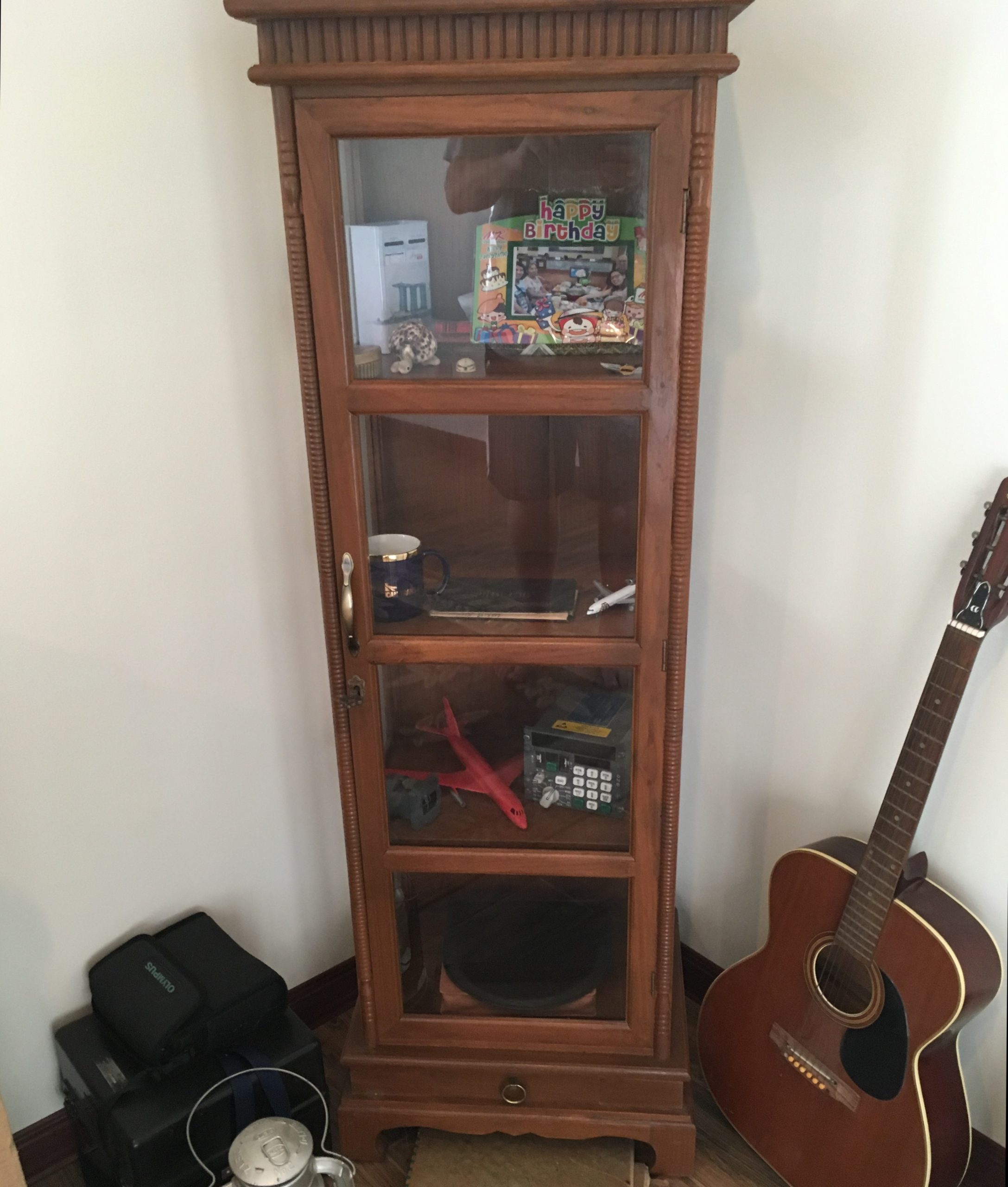
Photo: Mark Barnard
On every trip we took to Indianapolis my parents would treat me to a stop at the Indianapolis airport. This was long before “Indianapolis International” existed. At that point in history, it was named Weir Cook Airport. There was a small airport park at the corner of High School Road and Pierson Drive. The park was nothing spectacular, just a couple of picnic tables, a few maple trees, and a small parking lot oriented so you could watch the airplanes land. The approach end of the runway was right across the street from the airport park, separated from the airport park by only Pierson Drive and a security fence. When landing, the airplanes would seem so close it looked like you could hit one with a rock. I would watch with fascination as the 727s, DC-9s and 737s would come across “the fence” for landing.
Back on the ramp in Riyadh, we were preparing for the ferry to Ras al Khaimah. It was really troubling me that the airplane’s last flight was going to suffer the humiliation of being flown all the way with the landing gear pinned down. We had to fly it unpressurized; there was no real way around this requirement. But to fly it on its last flight without retracting the gear was unconscionable in my mind. The main reason for these requirements was that the airplane was out of date on just about every maintenance inspection that was due. Engines, landing gear, everything was out of date. The benefactor of meticulous maintenance by Saudi Royal Flight, it was obvious that the airplane was mechanically sound, and it had just been ferried from Jeddah to Riyadh a few months earlier with zero issues. But rules are rules and given its out-of-inspection status these were the requirements we had to meet. I talked with Steve and Mike, my close friends who were the other two members of the cockpit crew. They shared my sentiment that this was no way to ferry this airplane. We came up with an alternate plan.
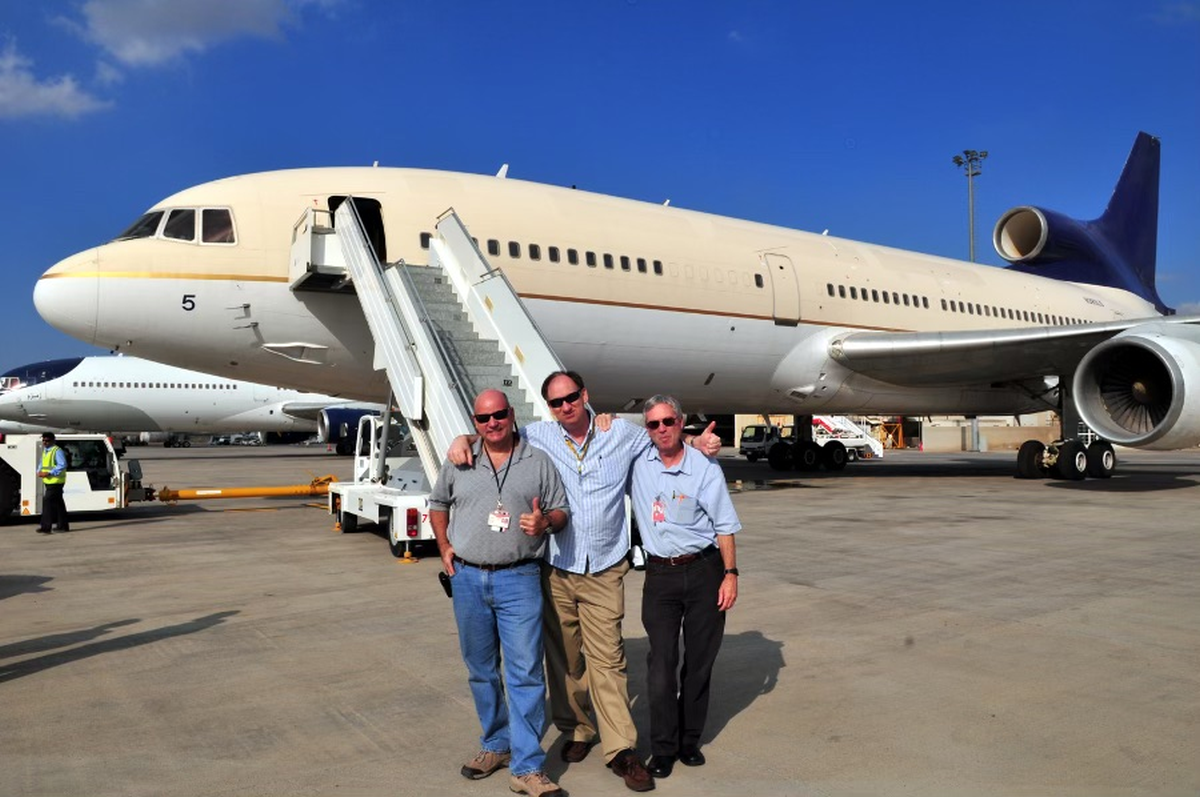
Photo Courtesy: Mike McCook
I told the maintenance crew preparing the airplane for the ferry that I didn’t want the gear pinned down.
The Saudi maintenance supervisor frowned. “Captain, that is part of the ferry permit procedure. The gear is out of inspection. We are required to pin the gear for the ferry flight.”
Implementing our plan with as stern of a face as I could muster, I said that I understood, but my concern was safety of flight. Given that the engines were out of inspection status, I wanted to be able to retract the gear after takeoff in the event we had an engine failure. In such an event, being able to retract the gear would be critical to the airplane’s performance. With all the drama I could summon for my performance, I told them that I’d hate to have to explain why a former Saudi Royal Flight airplane was a smoking hole in the Saudi desert only because the Captain was prevented from retracting the landing gear after an engine failure because of a paperwork requirement. I knew good and well that an engine failure wouldn’t result in such a catastrophic event, but I thought the theater might add a sense of urgency and credibility to my request. I proposed to him that we would leave the gear extended for the flight unless we had an engine failure, but I wanted the ability to retract the gear if it was necessary. Pinning the landing gear would make that option impossible.
“Captain, I must check with my manager.” My Saudi friend then scurried off, disappearing into the hangar and up the stairs.
The summer of my 14th year we were at the little airport park when I saw my first TriStar. When it first came into view on the approach, I didn’t know what it was, but I knew that it was bigger than any other airplane we normally see. It turned out to be an Eastern L-1011, and when it came into full view, I thought it was the most beautiful airplane I’d ever seen. The sun gleamed off its polished aluminum livery. The center engine was stylishly molded into the fuselage. Unlike the DC-10, whose number two engine sat up in the middle of the vertical stabilizer giving it the appearance of being a clumsy afterthought, the TriStar’s number 2 engine conversely gave the airplane a sleek, elegant, aerodynamic profile. The word “Whisperliner” was painted on the side. On the approach it looked as if the nose was pitched up higher than other airplanes, giving it the aura of nobility and pride, a look no other airplane I saw had. I was mesmerized. It was love at first sight. From that moment on I was completely enamored with the airplane. I knew right then and there what airplane I wanted to fly. I stopped drawing pictures of 747s and started drawing pictures of TriStars.
Over the next months I would write to the Lockheed factory and ask for pictures of the airplane. As an adult looking back, I can envision a secretary in an office reading a handwritten letter from a teenage boy asking for pictures of the airplane. I like to think that secretary had a smile on her face as she placed some pictures in an envelope and put them in the mail to this kid from Indiana.
That same summer I had my first flying lesson in a Piper Colt. Oftentimes, as adults reflecting on our childhood, we’re apt to remember times when we can honestly say that under the same circumstances, we’re not sure if we’d have done the same thing our parents did. Such was the case with my starting flying lessons. I had read in the regulations that you could solo a glider at the age of 14. Upon encountering this revelation, I marched my 14-year-old self into the living room where my dad was sitting, showed him the reg, and announced I wanted to start flying lessons. In my now-adult brain, I think I would’ve responded to that declaration with something like, “Well son, let’s wait until you’re a little bit older. If you’re still interested, then we’ll see.” A perfectly logical and doubtless-typical-parental response to a young teenager asking to start something that ambitious, not to mention expensive, at such a tender age. However, that’s not what my dad said. He looked at the book with the reg in it, looked back at me, and said, “Let’s go to the airport this Saturday and see what we have to do.” With that pronouncement from my dad my flying career started.
On my first lesson, the airplane wasn’t 100 feet in the air before I knew that I had discovered how I wanted to spend my life. It was so much better than it was in my imagination. In the following years, I soloed and received my Private Pilot’s certificate before I graduated from high school. All that time the letters to Lockheed continued, the L-1011 pictures and drawings kept coming, and I never forgot the TriStar that I saw in Indianapolis that day. But as I matured and started to learn more about the realities of how aviation works, I came to realize that it wasn’t as simple as showing up at an airline that flies the TriStar and saying, “I want to fly the L-1011.” Before anything else happens, you have to be hired by an airline that flies the airplane. And to get hired by that airline you must have mountains of experience. Then, once you manage to get hired at said airline you must reach the seniority level that allows you to hold that particular airplane. I came to realize that the TriStar was much further away than it seemed that day at the little airport park. I frowned at the thought that I would never get to fly the airplane I dreamed about.
Onward and upward. The years went by. Gathering my ratings, flight-instructing throughout college building experience, I managed to eventually be hired by a local commuter airline. But as time went by more reality began to set in. I had been flying the Fairchild FH-227/F-27 for a few years, which was a Part 121 airplane, but I didn’t have a significant amount of jet time, nor did I have military flying experience. At that specific point in airline history, both were virtually requirements to get a job flying for a major airline.
The calendar had now advanced to 1987. It was 13 years hence from my first TriStar encounter at the little airport park. The TriStar had been in service for 15 years. Production of the TriStar ceased three years earlier and the clock was ticking on its service life. Technology was changing. Just two years before the FAA approved 120-minute ETOPS operations and was now considering allowing 180-minute ETOPS. Translated to English that means routes that were once the exclusive domain of 3- and 4-engine airplanes could now be flown by airplanes with only two engines. TWA, one of the airlines that operated my beloved TriStar, had recently spent millions bringing their B-767-200 fleet up to 120-minute ETOPS standards because of the fuel savings vs. the TriStar on a transatlantic flight. The tea leaves weren’t hard to read. Even if I got hired by an airline today it would be many years before I held the seniority that would allow me to fly the airplane. That realization, and the gravity behind it, saddened me.
“Captain, my manager says he will approve the gear pins being left out, but you must agree to leave the gear extended unless an engine failure or other emergency occurs.”
“I will agree to that, no problem” (trust me…heh heh), I said making a concerted effort to conceal the elation that desperately wanted to appear on my face. The stage was set. There wasn’t going to be any gear down ferry for this airplane’s final flight. The requirement to fly the airplane unpressurized was a different story, not something we could worm our way around based on a technicality. We had to file a flight plan that would reveal our requested cruise altitude, and a copy of the flight plan had to be provided to the Saudi civil aviation authorities as part of the ferry permit. Even if we were to ask ATC to climb to a higher altitude after takeoff the authorities would know about it, and we might later have some explaining to do. One typically doesn’t request an “emergency climb” to altitude. So, we were stuck with flying unpressurized. But the indignity of a stiff-legged ferry flight was now, unbeknownst to our Saudi hosts or anyone but those of us on the crew, history.
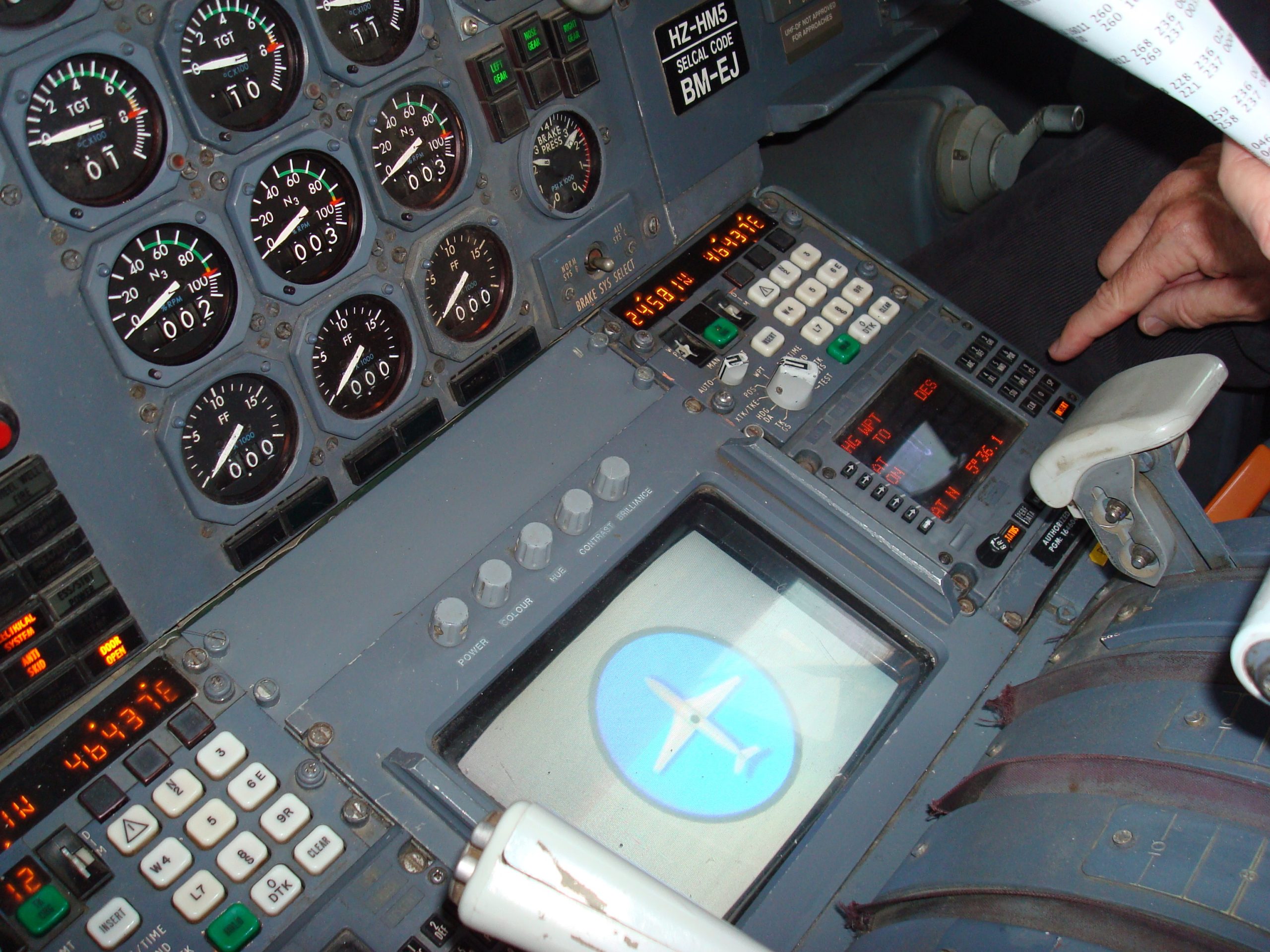
We hadn’t yet changed it to reflect a new SELCAL code or the new registration number.
Photo Courtesy: Mike McCook
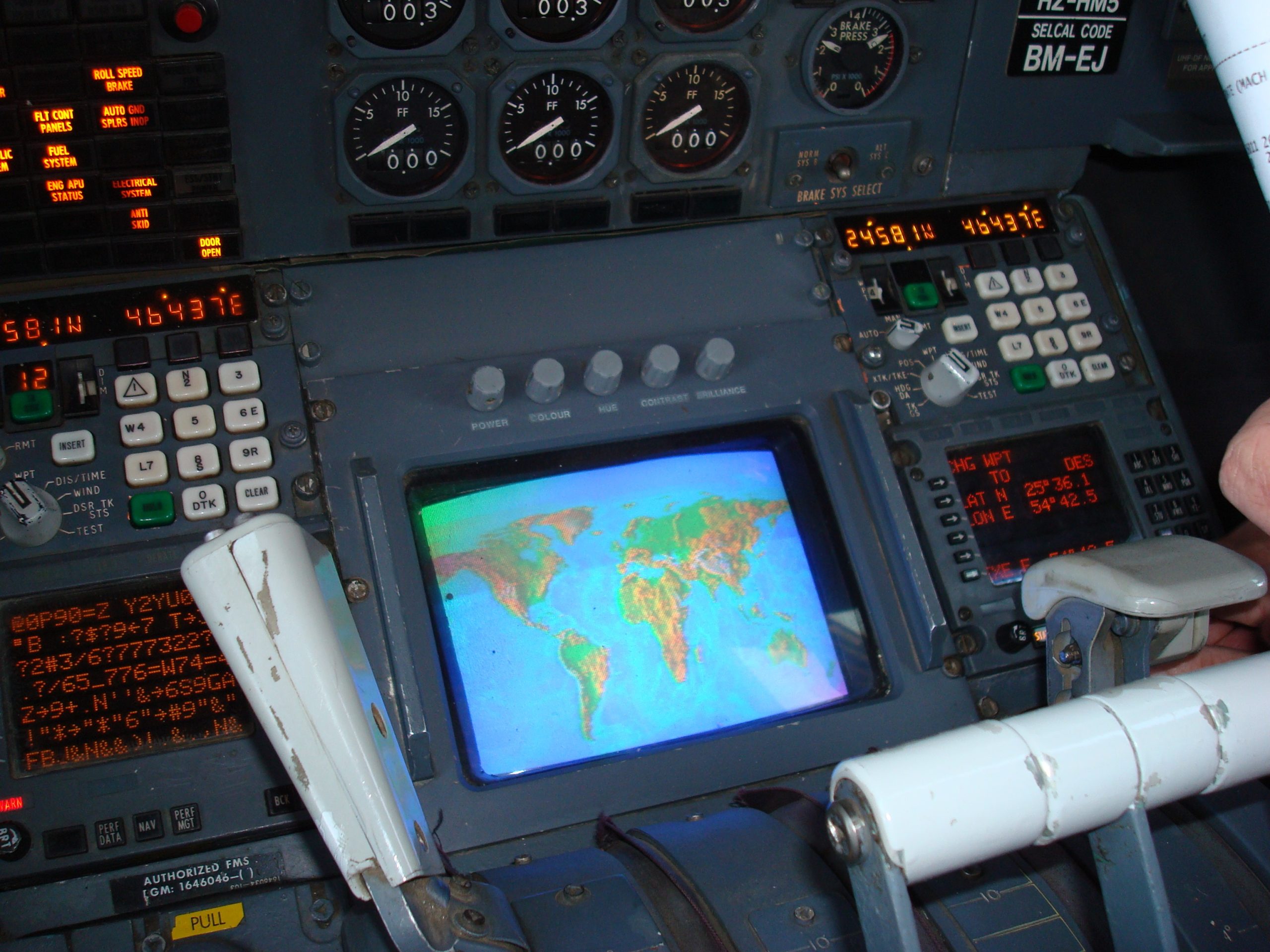
The map display comes up once the INS’s are aligned.
Photo Courtesy: Mike McCook
The time came to depart. There existed a paradox, an incongruity in my emotions on this flight. It was quite a thrill for me to be flying the last TriStar ever built, but at the same time, that excitement was wholly deflated by the fact that unless Big Guy’s lips weren’t moving in their usual fashion it was very, very likely this would be the airplane’s final flight. The engines were started one by one. The sounds, the sensations now so very familiar to me after my years flying the airplane, were all present as the airplane performed exactly as it was designed to during the engine start. The familiar growl of the Rolls-Royce engines as they accelerated after ignition, the starter valves closing at 46% N3 RPM, the sound of the air rushing into the cockpit as the packs were turned on . . . all was as it was supposed to be.
Some of us are fortunate enough during our careers to encounter what I think Ernest K. Gann may have called a “Fate is the Hunter” moment. Sometimes things happen serendipitously that you couldn’t have gotten to work out no matter the level of planning or preparation. One of those moments occurred for me at an Italian restaurant in Pittsburgh while doing simulator training for new hires on the FH-227. My close friend Gene Freeman had been hired by American Trans Air the previous fall. Gene had been flying the BAC-111 for our regional airline. Doubtlessly the most brilliant individual I’ve ever known personally, Gene was an accomplished pilot. He encouraged me to apply to American Trans Air, which of course I did. It was no small incentive for me to do so given that American Trans Air operated TriStars, having acquired nine of them from Delta Air Lines in 1986. I applied but received not even an acknowledgment that my application was delivered. Very little jet time, no military experience. It was no surprise to me.
It was my tradition to take new hires out to dinner at this wonderful little Italian place the evening prior to commencing our simulator training. Always consisting of only the three of us that would be present in the simulator, this was more of a team-building exercise than anything. Additionally, it was a chance to calm the nerves of what were usually young pilots embarking on their first encounter with Part 121 airline training. We would sit and talk, discuss the upcoming sim training and how it would be conducted. What the expectations were, etc. It can be quite stressful on a young person experiencing their first training of this type. My goal was to get the trainees to relax so they had a better chance of succeeding.
As providence would have it, seated at the table next to us there was an older gentleman with two younger fellows. After a period of time, the older gentleman leaned over and said he’d been hearing some of our conversation and asked if we were pilots? I said yes, we are. He then asked who we flew for and what airplane were we flying? I answered his query, and his reply surprised me. He said, “I’m the Director of Training for American Trans Air and we’re here doing 727 sim training.” Responding in a way that is quite uncharacteristic for me, from whence it came I don’t know to this day, I blurted out, “Is that right? I sent an application in to you guys, and you didn’t even respond to me.”
After realizing how that probably came across to him, I was shocked at the tone of insolence I had probably just conveyed. He responded by telling me to come to the 727 simulator the next day after our training period was finished. He said, “we’ll put you in the 727 sim and see if you can fly.”
The simulator flight went great, and I was offered an interview at American Trans Air. I dared hope that the TriStar was in reach. American Trans Air had just bought the airplanes not even two years previously. They weren’t going anywhere anytime soon. But my Ernest Gann moment had not yet fully played out. At the completion of my American Trans Air interview, I was told that the company had a full complement of 727 pilots, but they were short on L-1011 crews. I would be hired as an L-1011 copilot!
The elation, the ecstasy I felt at that moment is beyond my poor power to articulate. The dreams of a 14-year-old boy had just come true. The letters to and pictures from Lockheed all those years ago didn’t seem silly anymore. I wished I could talk to the kind secretary who sent them to me all those years ago, but I didn’t even know her name. I know not whom to credit for my inconceivable gift of good fortune. God, prayer, fate, destiny, or maybe just plain ol’ blind, dumb, stupid luck…perhaps a combination of all of them . . . I’m not really sure. The only thing I can say for certain is that dreams do come true, because at that moment mine did. No one will ever convince me otherwise. The first person I called to tell was my mother. My father unfortunately had passed away a couple of years previous, but no one would understand the depth of what this meant to me more than my parents.
We lifted off the ground at Riyadh bound for Ras al Khaimah. Our “evil plan” for the landing gear was to leave it extended until we were certain we were no longer under the observation of the control tower at Riyadh and certainly out of view of the maintenance facility we left from. After that . . . up came the landing gear. The airplane was now clean and flying like she was meant to fly, although just at a much lower altitude. We cruised at 9,000 feet to avoid the necessity of wearing oxygen masks. We looked at each other and laughed, all self-satisfied with our landing gear coup.
As we proceeded along with the flight, we came to appreciate that we were cruising at such a low altitude. For one, thing we were slow, restricted to 250 knots indicated below 10,000 feet. Between the speed and our low cruise altitude, we enjoyed a view of the Saudi desert that we would’ve never had on a normal flight. The dunes of the desert were clearly visible, spotted with the occasional camel herd which we could easily see. We avoided Qatari airspace to the south and set our course just off the UAE coast flying over the waters of the Persian Gulf. We could see the oil rigs clearly. It was an amazing sight that few people get to experience. Ras al Khaimah sits very near the tip of the horn of the Saudi peninsula that defines the Strait of Hormuz. We could see the oil tankers. Our low cruise altitude and the crystal-clear desert weather provided us a vista that we otherwise would have never been able to witness.
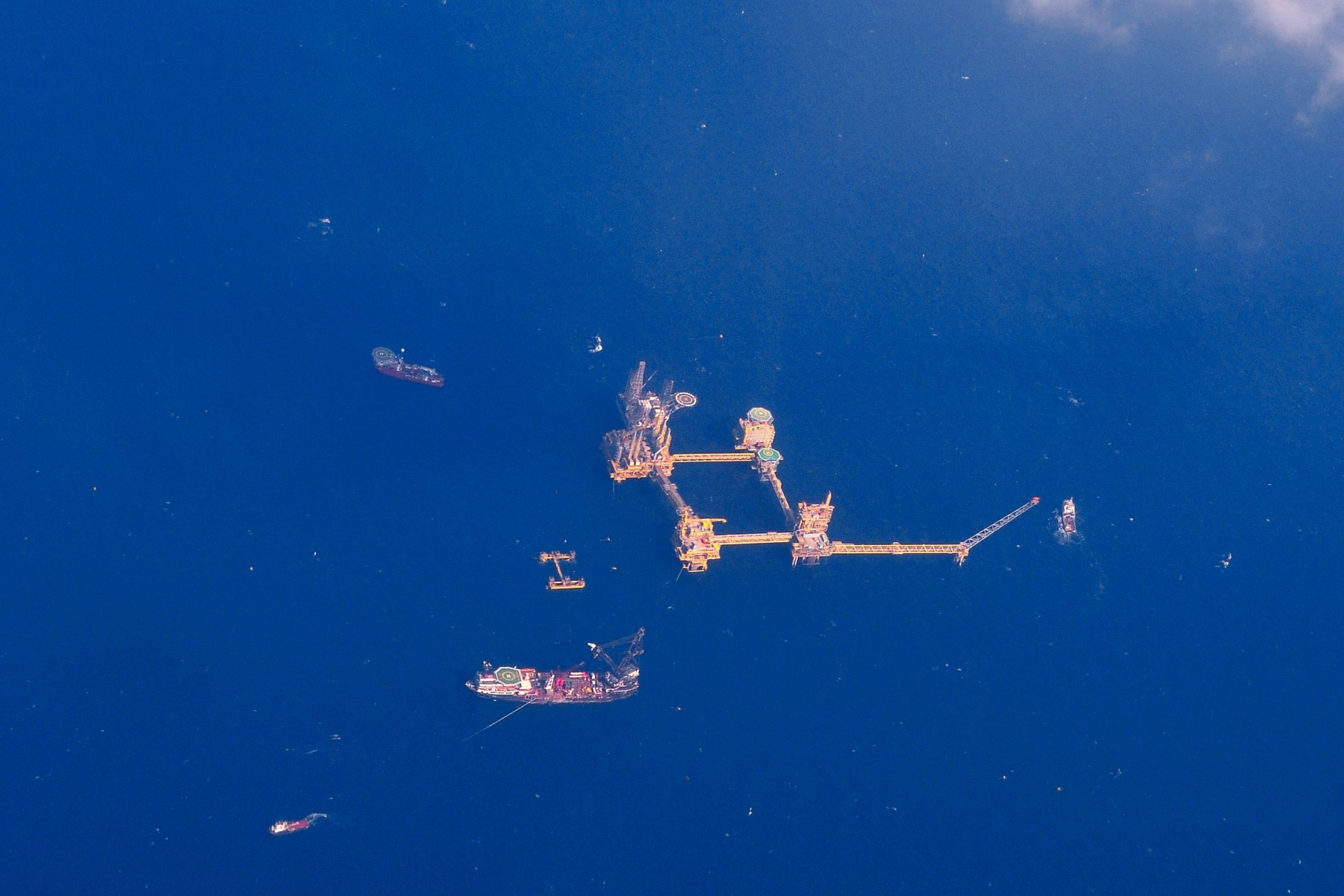
Photo Courtesy: Mike McCook
The Ras al Khaimah runway was now in sight. The excitement of the sights we enjoyed during our flight is now completely overcome by the finality of the landing. The closest I can come to describing my feelings were that sense of sadness and regret that one feels when they are taking their beloved pet to the vet to be euthanized. While we know the purpose of our journey, our cherished pet knows nothing of it. Our pet merely trusts us to take it somewhere it is supposed to be. The throttles came back for what would be the very last time. There was a little anxiety as we lowered the gear. If it failed to extend then we were “busted”, and our plan exposed. But as it had done for the last 20+ years the airplane did what it was supposed to do. The flaps were extended, and I sat the TriStar down on the Ras al Khaimah runway as gently as I could. We taxied to the ramp very slowly, wanting to extend the flight for as long as we possibly could. We shut the airplane down, ran our securing checklists and the crew exited the airplane. I was the last one off of the airplane as I wanted to take a few pictures of the interior before deplaning. As I walked out of the cockpit I said aloud, as if the airplane could hear, “I’m sorry. I wish there were something I could do. I really do.” I took a couple of pictures of the airplane’s data plate as I exited the left forward entrance door.
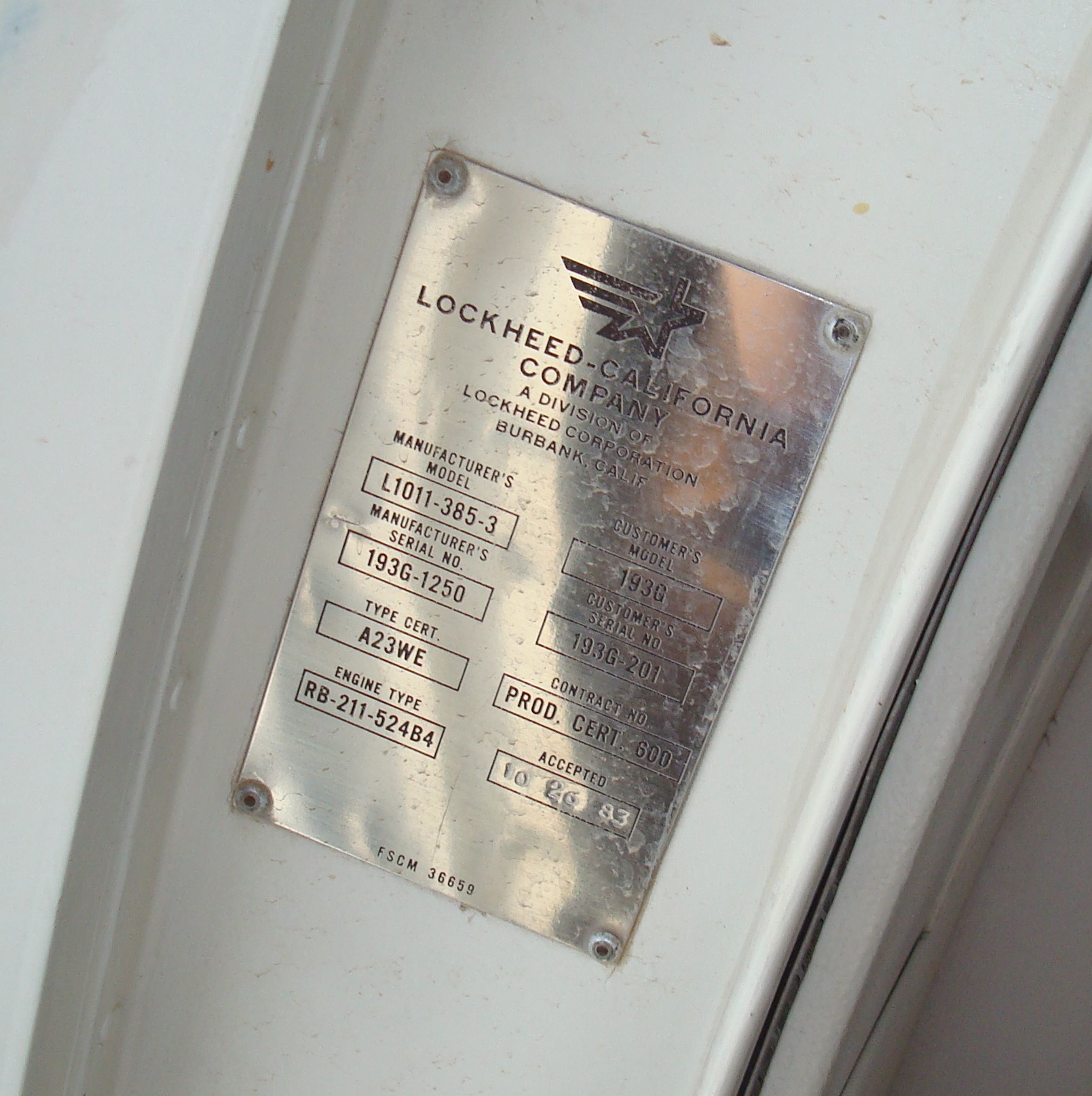
Photo: Mark Barnard
Thus ended the last flight of the last TriStar. When we arrived at the hotel and I got to my room I was overwhelmed emotionally. I’d be lying through my teeth if I told you I didn’t shed a tear.
The TriStar and I had some incredible adventuresduring our time together, both prior to this flight and many afterwards. I flew the airplane on six continents. It took me to the Pyramids of Egypt, to the wonder and history of Europe, to the rain forests of South America, the Great Barrier Reef of Australia and to see the ancient wonders of the Orient. Wake Island, Fiji, Pago Pago and other Pacific Island paradises. It saw my mother riding with me in the cockpit jumpseat from Washington Dulles to Indianapolis. It allowed me to fly with some of my heroes like Bill Weaver, Jeff Fowler, Don Moor, Bob Taylor and Rodney Boone. I was part of launching a rocket off the bottom of the airplane from 39,000 feet. Through the TriStar I met friends that I would have for life. Steve and Mike, my fellow crewmembers on the last flight of the last TriStar are still close friends with whom I have regular contact. It saw me as the TriStar Fleet Manager for American Trans Air for a bit over five years, a position and period which I look back upon as my proudest achievement in aviation. Along with my dear friend Gene Freeman and the dedicated, professional crews flying the TriStar we achieved a level of success with the airplane that our upper management not only disdained but frankly could simply not understand. Together Gene and I flew the airplane near the North Pole, reaching a latitude of 87 degrees north. No one else except the RAF has done so with the TriStar. I did things and went to places riding safely on the back of my magic TriStar carpet that was far beyond the wildest dreams and imagination of a teenage Indiana country boy.
Professionally I credit the airplane with evolving me into the pilot I became. Every professional pilot must pass through what I call a seasoning, a period where our skills, habits and attitudes are tempered in the crucible of experience and honed to a fine edge. The TriStar was a wonderful teacher to me in that respect. In the TriStar I learned to manage a widebody aircraft, learned to prioritize tasks and developed leadership skills. Today, even after flying marvelous airplanes such as the 747-400, I’m awed by the foresight the men and women who designed the TriStar possessed. Like the mobile phone and tablet devices we use today, its systems walk that fine line between being deeply complex yet not complicated in the operational arena. It gave me a deeper understanding of how airplanes work and how they fly and the difference between those two. There isa plethora of what one would consider small things in the airplane that someone obviously devoted a lot of time thinking about during design and development. Boeing’s magnificent 747-400, with its glass cockpit, FMS and two-pilot technology, is at its best merely a faint copy of the TriStar.
The pragmatists, the engineers, the skeptics who don’t believe an airplane can have a personality, will tell you that it’s impossible for a mechanical device such as an airplane to have a character or an essence. But they just don’t understand. I know of more than one poetic pilot who waxes lyrically about the soul of his airplane, anthropomorphizing the tons of aluminum, wire, cable and glass that make up his machine. But in the case of the TriStar, specifically in the case of the TriStar and me, there’s no doubt that in my mind the skeptics are dead wrong. I have a connection to the airplane that is rarely duplicated in my interactions with sentient beings. The airplane is a part of me, as surely as my hand or foot is. I’ve flown some wonderful airplanes during my career but none of them even come close to the TriStar. It does, and will always, define my career in aviation.
Tags: L-1011, Lockheed TriStar
Trackback from your site.


Tareq Alghamdi
| #
Thank you Mark for the nice story. I work for Saudia Royal flight and I was lucky to find this story which I really enjoyed reading it. I remember when this Aircraft flown from main base in Jeddah to Riyadh after it was parked in hangar for long time. We all went out of offices and stayed behind the runway fense to see this beautiful airplane takeoff for the last time and say goodbye. I remember some of my colleagues who were flying on it as flight tech and how sad they were at that time. Everyone is saying this airplane was a revolution in the Aviation industry.
Thanks again sir.
Reply
Derek Jones
| #
I spent my final 12 years with B.A. as a Flight Engineer on the Tristar , I trained on the same course as Chris. Inward who penned his love for the A/C above- on 22 April 22. I agree with all he said and feel so lucky to end my my 30 year aviation career on such a great aircraft. Thank you Mark for re-kindling may good memories.
Reply
Alain Delisle
| #
## Comment SPAM Protection: Shield Security marked this comment as “Pending Moderation”. Reason: Failed AntiBot Verification ##
Hi Mark from France, yes great story. Flew the aircraft a few years but unfortunately not for great companies! I can easily say the aircraft was robust and forgiving. Flown the DC10 and MD as well……. The L10 was a gentleman’s aircraft.
Reply
Steven Stewart
| #
## Comment SPAM Protection: Shield Security marked this comment as “Pending Moderation”. Reason: Failed AntiBot Verification ##
Wow Mark! I remember when you were doing this. I am so proud to call you friend.
Reply
Mark T.
| #
Hi Mark. What an incredible story. I’m glad to read that your childhood dreams were realized, all the way up to flying the last one ever made. The Tri-Star has always been a favorite of mine as well. Circa 1973, when my Dad was in the Army, we’d have to usually fly somewhere to visit any relatives. I was 8 years old, when I got to ride on my first Delta L-1011. About 20 years later, when I was an air traffic controller, I knew the L-1011’s days were numbered. As a controller, we were allowed to request to ride jumpseat on most of the major airlines, space permitting. By then, domestic L-1011’s were kinda scarce. I found a flight from PDX to SLC on one. I made my way from back East, to PDX and made it onto that flight deck. After being on the flight deck of 727’s, MD-80’s, DC-10’s, 757’s and 767’s – I will say that the L-1011’s experience was by far, the best. The cockpit area is huge. The jumpseat sat up high, but back far enough, that I could take everything in. The takeoff out of PDX was the smoothest rotation I’ve had. I loved the fact, that all 3 pilots were continually engaged in flying the plane. So much more exciting than watching a “set it & forget it” aircraft! I only wish I had videotaped it that day. As an Enroute Controller working in a Center, I worked a handfull of L-1011’s over my career, mostly ATA’s. It’s a bygone era that I am glad I was a part of. Cheers.
Reply
Jim Hoban
| #
Thanks for reminding us of how lucky we were to fly the L-1011. The article really brings back great memories of the aircraft as well as the quality and joy both it and you brought to the job every day. I was never more comfortable than watching you bring her into MCO during a two-engine ferry.
Reply
pat hassett
| #
i am looking into a mirror of what i thought of the tristar; every touch, feel, CB reset and distinctive sound comes back as if i were still on it. i flew just about every version and in every seat learning…..and learning. when you thought you had it all sucked in, the lady showed you something new. on a 747-400 now and i still certainly miss stuff from the 1011. even the A320…..all are just not as sweet. thank you for the memories opening up
Reply
Chris Inward
| #
What a wonderfully written piece of nostalgic aviation history. The nod to Ernie’s definitive aviation book was the icing on the cake. I had the privilege of flying as an FE on the brilliantly designed Tristar for the last 12 years of my flying career. I too loved the airplane, and will cherish this piece of prose in its memory.
We have never met, my friend, but please join me in raising a glass to our beloved Tristar.
Reply
Kevin Friel
| #
Mark,
Thank you for sharing this wonderful story. I only experienced 10 years on that fantastic machine, and to date it remains my favorite.
Reply
Charley Cleaved
| #
Wonderful story. My best work years were the 9 years at ATA where I was VP treasurer and fleet guy. “Touched” our 19 TriStars often. Bought the five RJA -500’s from theJordanians.
Reply
Ryan Kenyon
| #
I only got to fly on one once. Gulf Air metal with a TWA crew LHR-JFK summer 1988. I remember how quiet it was even on takeoff. The interior had recently been updated to a modern (for the time) pastel sheme. Very roomy. Great airplane.
Reply
Bruce Sylvester
| #
A wonderful read, Mark. I was fortunate enough to get some right seat time in the airplane before I was laid off and moved to my next airplane during my career as an aviation vagabond.
Reply
Rafael Copa
| #
Wow, thank you. Great story, thanks for documenting this last flight. I loved this plane as a boarding agent for Eastern. Pass rode so many times. To this day there is no other like the L-1011.
Reply
John Danner
| #
Just read your story – loved it. I can so relate to your childhood memories about loving airplanes and aviation in general – many similarities to my own history. Also, so glad you still have and cherish that Red DC-8. That’s a lifelong keeper.
Reply
Luke
| #
Thanks so much for sharing! As a school kid I hounded airline offices for brochures for years!
Reply
Jim Johnson
| #
Great story Barnie. Had the pleasure of hosting Bob Gordon at my house last week before visiting you. Very jealous of him still flying the only flying Tristar. We all had a very good gig. Miss it everyday. You and Gene have had a very interesting career after ATA. Good to hear you’re both doing well.
Reply
Adrian Gee
| #
Thanks for that great story. Reminds me of my childhood.
Reply
Daniel DePiro
| #
Wow Mark! Beautifully written about our loved TriStar!
So wish we could turn back the hands of time and fly the L1011 again. I am grateful to have flown 2 of the 3 seats. I tell all that I fly with today how the TriStar was so superior to any aircraft that I have flown and I still wear my TriStar pin on my tie, have a Plane Tags L1011 tag on my flight bag, and my American Trans Air leather jacket!
Take care my friend. Hope to see you again on the line!
Dan
Reply
Musilli Ed
| #
Great article. Thank you so much for bringing back cherished memories. I was a TriStar tech rep for Lockheed, and was out in the field with the first airplane delivered to Eastern in 1972. Although I finished my Lockheed career as a contract administrator title transferring Saudia’s final three aircraft, I was – prior to that – Lockheed’s managing tech rep in Jeddah. Had the pleasure of working with three of the Lockheed pilots you mentioned i.e., Bill Weaver, Don Moor and Rodney Boone, on several assignments. Thanks again for refreshing great memories of a great, great airplane.
Reply
Nancy Stout
| #
I cheered when you stated that Eastern Airlines was the first 1011 that you ever saw. I loved working that aircraft and if there was one still flting, I may still be flying too. Great story…and thank you, that is a story from your heart.
Reply
MIKe McCOOK
| #
Wow! That brings back such great memories. I’ve had many key moments in my 40 years of flying. This one, however, I will always remember because of its significance in L-1011 history. Sadly, it was an unceremonious ending for this, the last TriStar.
Reply